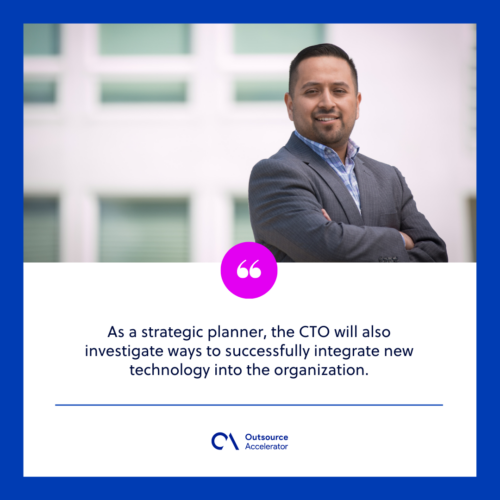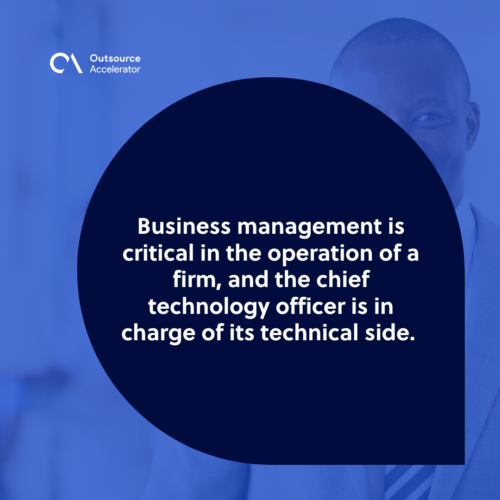Chief technology officer
Definition
What is a chief technology officer?
A chief technology officer (CTO) is a C-level executive in charge of a company’s technical needs and requirements. The CTO is also in control of the research and development of the business.
The chief technology officer is also known as the chief technical officer, who assesses a company’s short- and long-term needs.
Types of chief technology officers
Companies that focus on scientific and technological products appoint chief technology officers who are responsible for intellectual property monitoring and have industry experience.
However, the chief technology officer’s tasks and responsibilities are also determined by the business. Chief technology officers are often classified into four types, each with its own set of responsibilities.
Supervisor of infrastructure
This chief technology officer is responsible for a company’s data, security, maintenance, and network. They are also in charge of the company’s technology plan.
Strategic planner
This type of chief technology officer may visualize how technology will be employed within the organization while developing the company’s technological strategy. As a strategic planner, the CTO will also investigate ways to successfully integrate new technology into the organization.

Consumer relations
The chief technology officer who takes on the persona of consumer liaison helps the business achieve a better understanding of the target market. With this, the company can deliver products and services that meet customer expectations and ensure satisfaction.
Thinker
This type of chief technology officer will assist in the development of corporate strategy and the building of technology infrastructure. They may also play a role in the analysis of target markets and the creation of business models.
Responsibilities of a chief technology officer
Here are the key responsibilities of a CTO:
Technology leadership
The chief technology officer is a company’s technological leader. Their primary purpose is to develop a technological vision that is consistent with the organization’s overall goals and objectives.
In addition, the CTO is in charge of employing technology to achieve the company’s goals and creating a tech-based culture in which innovation may thrive.
The chief technology officer is also in charge of forming the company’s technical team and integrating technology in such a manner that other employees can comprehend and appreciate it.
Technology research and development
A chief technology officer’s key purpose in a corporation is technology research and development.
Technology thrives on invention, and there are several new trends in the digital sector annually. It is the CTO’s obligation to keep an eye on these developments and monitor the market to deliver the best competitive edge to their organization.
Product development
It is also the chief technological officer’s role to collaborate closely with the chief product officer (CPO) on product creation and enhancement that will increase revenue and build a brand for the company.
Business management
Business management is critical in the operation of a firm, and the chief technology officer is in charge of its technical side.
Companies use various software for business administration, such as customer relationship management software and point-of-sale software. CTOs should ensure that they are integrated into the organization and functioning properly.

How to become a Chief technology officer
Here are the skills needed to become the chief technology officer of a company:
Technical skills
A chief technology officer should be well-versed in all of the technical abilities necessary. This comprises knowledge and expertise in software development, programming, system design, and product development.
A CTO should be ready to explore and learn all emerging technologies and how they might be valuable to the business, in addition to knowing the fundamentals of technology.
Business skills
The chief technology officer’s primary responsibility is to oversee a company’s technological components and guarantee that they deliver the most advantage.
However, since the CTO is responsible for managing the whole IT department, business skills are required. The capacity to employ technical expertise to further corporate objectives is a critical component of this.
Leadership skills
A chief technology officer must be a leader to properly drive the company’s innovation. They should understand how to motivate, recruit, and lead the greatest technical support personnel.
The difference between the chief technology officer and the chief information officer
Chief technology officers usually collaborate with chief information officers (CIOs). However, the responsibilities are not equivalent.
A CIO’s responsibility in the IT department is often considerably more hands-on. They collaborate directly with IT employees to create and design solutions that keep things functioning daily.
The CTO, on the other hand, is more business-oriented. They are in charge of the whole technology infrastructure.
In the case of digital transformation, a CTO can create an overarching strategy for modernizing a firm’s technology to adapt to the future better. A CIO can be in charge of the specifics on the ground, supervising the adoption of certain technologies.







 Independent
Independent




